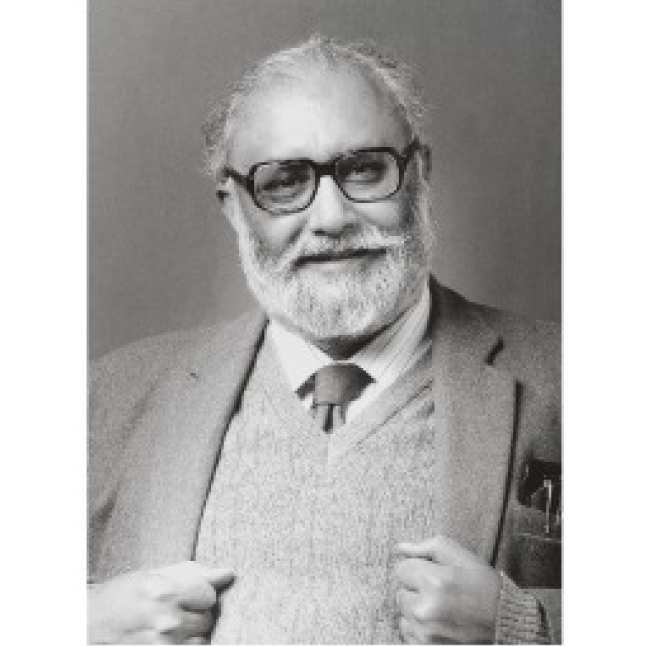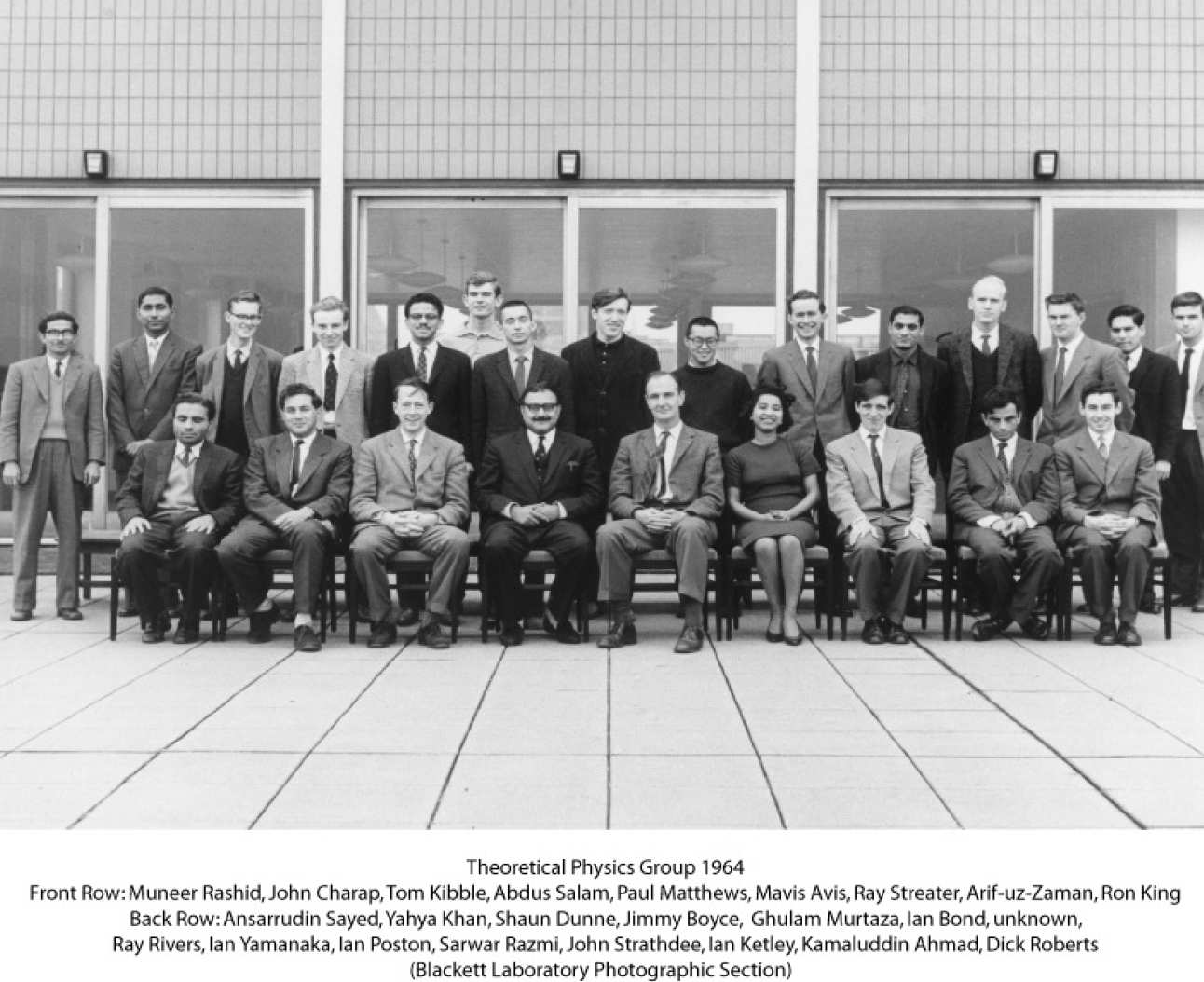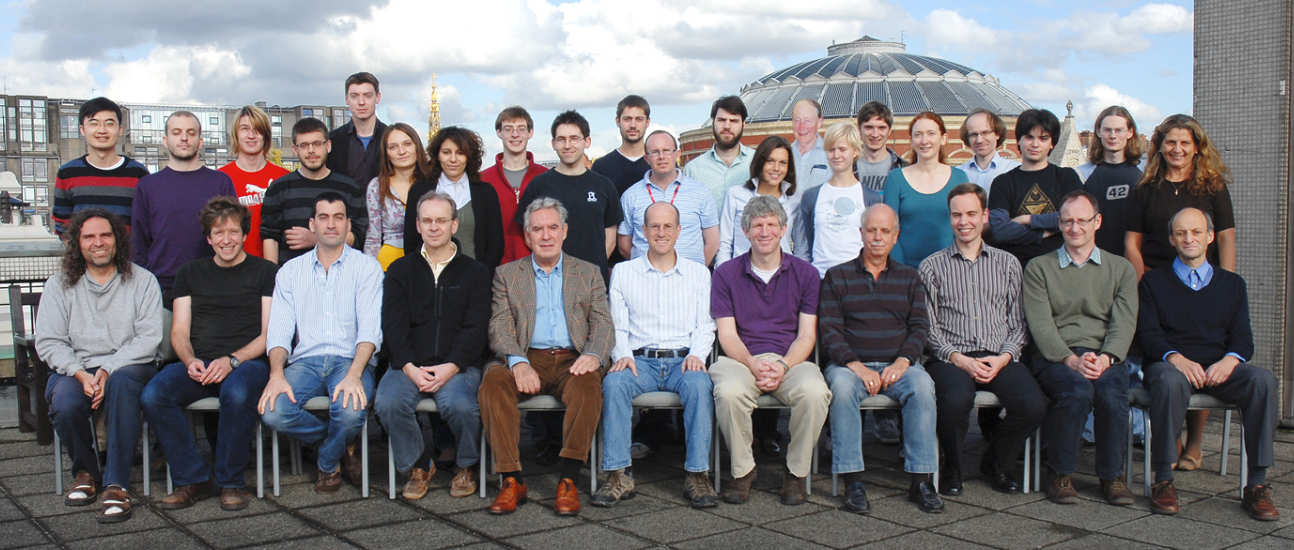History of the group

The Group was founded by Abdus Salam in 1956. Salam was born in 1926 in what is now Pakistan, and came to this country after the war to study in Cambridge. This was a time of great excitement in theoretical physics because of the development of renormalization theory. Quantum electrodynamics (QED), the earliest quantum field theory, describes interacting photons and electrons. Previous calculations beyond the lowest-order approximation had always yielded infinite answers. But around 1947 three people, Julian Schwinger, Sin-itiro Tomonaga and Richard Feynman, independently found a way of taming the infinities, yielding accurate calculations of quantities such as the magnetic moment of the electron and the 'Lamb shift' of energy levels in hydrogen. Salam's PhD under the supervision of Nicholas Kemmer addressed some key issues in the theory, and immediately established him as a major player in the field. Salam collaborated with another student of Kemmer's, Paul Matthews, who had just completed his PhD and was about to go to spend a year as a postdoc at the Princeton Institute of Advanced Study. It was arranged that Salam would go too, with Matthews formally supervising him there. Following the success of QED in explaining the electromagnetic force between charged particles as due to the exchange of photons, the natural next step was to seek a similar theory of the strong nuclear forces that bind neutrons and protons in atomic nuclei. The best candidate at the time was the meson theory of Hideki Yukawa, in which the strong forces were mediated by exchange of spinless pions (π mesons). Together Matthews and Salam succeeded in extending the idea of renormalization to theories of this type. Although this theory has been superseded — by quantum chromodynamics (QCD) — this was an important step forward. Thus began a most fruitful long-term collaboration.
In 1956, Salam was appointed to the chair of Mathematical Physics at Imperial College, initially in the Department of Mathematics, then occupying the old Huxley Building. This had at one time housed the Royal College of Science, one of the three constituent colleges of Imperial College, where Thomas Huxley and H.G. Wells among others studied. The building is now the Henry Cole wing of the Victoria & Albert Museum. He brought Paul Matthews with him as a Reader. Together, they created one of the most exciting theoretical physics groups in the world. Academic visitors included many of the leaders in the field: Murray Gell-Mann, Steven Weinberg, Stanley Mandelstam, Ken Johnson, Susume Kamefuchi, Sidney Bludman, and many others. The photo on the left is of the Group in 1964.
 The Group rapidly attracted a large number of PhD students, and also developed, with others in the Mathematics Department, a one-year postgraduate course, initially leading to the Diploma of Imperial College (DIC). First-year PhD students also attended these lectures. More recently, this has become a full-fledged MSc course on Quantum Fields and Fundamental Forces, which is one of the leading courses on the subject and continues to attract large numbers of students from around the world.
The Group rapidly attracted a large number of PhD students, and also developed, with others in the Mathematics Department, a one-year postgraduate course, initially leading to the Diploma of Imperial College (DIC). First-year PhD students also attended these lectures. More recently, this has become a full-fledged MSc course on Quantum Fields and Fundamental Forces, which is one of the leading courses on the subject and continues to attract large numbers of students from around the world.
Salam bitterly regretted the fact that he was unable to pursue his chosen career of research in his native country, and resolved to try to help others who found themselves in a similar position. His opportunity came when he was appointed the Pakistani delegate to the International Atomic Energy Agency (IAEA). He single-handedly managed to persuade his fellow delegates to support the idea of setting up an International Centre for Theoretical Physics, where scientists from developing countries would be able to come on a regular basis to interact with leaders in the field, while continuing to work in their home countries. He received strong support for the idea of siting it in Trieste from the Italian Government and the Trieste City authorities. The ICTP was inaugurated in 1964, and has been a great success. It is now officially the Abdus Salam ICTP.
From then on, Salam spent part of his time in Trieste and part in London. He continued to play a very active role in the research work of the Imperial College Group. The day-to-day running of the Group passed to Paul Matthews and later, when Matthews became Head of the Physics Department in 1971, to Tom Kibble.
In the early years, the major research themes were symmetries and unification.
The most pressing problem seemed to be to understand the strong interactions, but unfortunately the calculational method used in QED of expanding in powers of the fine structure constant, a dimensionless parameter related to the electron charge and approximately equal to 1/137, did not work for strong interactions because the corresponding parameter is of order unity. This was a time when experimenters were discovering a whole zoo of new particles, especially huge numbers of hadrons (strongly interacting particles). To make sense of this in the absence of any usable fundamental theory, theorists instead looked for symmetries.
It was clear that the particles could be grouped into families. Werner Heisenberg had pointed out that the proton and neutron were very similar in so far as their strong interactions are concerned. This similarity was described by a symmetry between them, now called isospin symmetry, because it is mathematically akin to the rotational symmetry between up and down spin states of an electron; both correspond to an SU(2) group. Isospin is an approximate symmetry because the proton and neutron differ in regard to their electromagnetic interactions. It became clear that the newly discovered particles could be grouped into larger multiplets, related by even more approximate symmetries. The Group was heavily involved in this quest. A major advance in the field was the discovery of a larger SU(3) symmetry, independently by Murray Gell-Mann, who christened it the 'eightfold way' because it groups particles into octets, and Yuval Ne'eman, who was then a student of Salam's. (It is now understood as a symmetry between the three lightest quarks, the constituents of hadrons.)
The other major theme was unification. The success of QED naturally led to a search for similarly effective theories of the strong and weak nuclear interactions, and, even more ambitiously, for a unified theory of all of them. QED is a gauge theory, in which a global symmetry (in that case a U(1) symmetry related to electric charge conservation) is extended to a local symmetry, where the parameters vary in space and time. From an early stage, Salam was convinced that a unified theory must also be a gauge theory. In 1954 a gauge theory based on the SU(2) isospin group was developed by Yang & Mills, and independently (though never published except as a Cambridge University thesis) by a student of Salam's, Ronald Shaw. This was intended as a theory of strong interactions, and as such proved to be incorrect, but it formed the basis of later theories of the weak interactions.
Because of the difficulty of calculating with strong-interaction theories, attention turned to the weak interactions. It was realized that they could be understood as due to the exchange of particles called W bosons, which like the photon have unit spin but unlike it come in two varieties, W±, carrying positive and negative electric charge. This led to speculation that it might be possible to construct a unified theory of weak and electromagnetic interactions, involving a symmetry between the W± ; ; and the photon, γ. Salam and his collaborator John Ward took several tentative steps i n this direction, postulating an SU(2) symmetry akin to isospin.
There were, however, formidable problems to be overcome. The z ero rest-mass of photons explains the long range of the electromagnetic force, described by Coulomb's law. But the W bosons had to have a very large mass to explain the short range and weakness of the weak interactions, whereas it appeared that gauge particles should normally be massless, like the photon. Moreover, the weak interactions, unlike the electromagnetic, were known to violate parity conservation, meaning that they would not appear the same if viewed in a mirror. Clearly, if a symmetry existed between W± and γ it had to be an approximate, broken symmetry. One natural way of achieving that was by spontaneous symmetry breaking, the idea that the underlying basic theory is completely symmetric but its ground state or vacuum state is not. Examples of this phenomenon are well known in condensed matter physics, for example the breaking of rotational symmetry when a crystal forms. But it was generally believed that spontaneous symmetry breaking in a relativistic theory would always imply the existence of particles with zero spin and zero rest-mass, so-called Goldstone bosons.
The eventual solution to this problem was what has come to be known as the Higgs mechanism. This was developed independently in three different papers, all published in 1964, showing how spontaneous symmetry breaking could give mass to the gauge bosons while simultaneously removing the unwanted Goldstone bosons: one by two Belgians, François Englert and Robert Brout, one by Peter Higgs in Edinburgh, and the third at Imperial College by two American visitors, Gerald Guralnik and Carl Hagen, together with Tom Kibble. Later, Tom Kibble studied the detailed workings of the mechanism in the case of non-abelian guage symmetries. The particle involved in this mechanism, the Higgs boson, was only discovered in 2012 at the Large Hadron Collider in CERN. In 2010 Englert, Brout, Higgs, Guralnik, Hagen and Kibble were jointly awarded the Sakurai Prize for Theoretical Physics.
Another basic ingredient was needed, however. The theory could not be made to work with the SU(2) symmetry group. The key here was to extend the symmetry, to SU(2)×U(1), and include another neutral boson, called Z0. This idea had actually been floated earlier by Sheldon Glashow, but without the feature of spontaneous symmetry breaking. It took another three years to put the two together, in the electro-weak theory, developed by Steven Weinberg in 1967, and independently by Salam (published in 1968). The theory was triumphantly verified by the discovery at CERN in 1973 of the W and Z particles. For this work the 1979 Nobel Prize for Physics was awarded to Glashow, Salam and Weinberg.
Later Developments
Following the success of electro-weak unification, Salam made important contributions to the idea of grand unification, the effort to construct a unified theory of electromagnetic, weak and strong interactions. With Jogesh Pati he developed an SU(4)×SU(4) grand unified model. They were the first to suggest in the context of a specific model that the proton might be unstable, though with a lifetime much longer than the age of the universe — a prediction that has yet to be confirmed.
Salam was very much involved in the early stages of this development of supersymmetry, a symmetry that, uniquely, relates fermions to bosons. A notable contribution was his development, with his former student John Strathdee, of superfield theory, which has proved to be a powerful tool. He also became very interested in supergravity, the supersymmetric extension of general relativity, and in the ideas of Kaluza and Klein that our universe has additional dimensions, beyond the familiar four, that are curled up so small as to be normally invisible to us. Many of these themes have been revitalized within the context of superstring theory. This is currently the front-runner among attempts to reconcile and unify the two great theoretical innovations of the twentieth century, quantum mechanics and general relativity.
Around this time, David Olive made substantial pioneering contributions to the perturbative structure of superstring theory. He also made fundamental discoveries concerning the properties of magnetic monopoles and instantons, which play an important role in the non-perturbative structure of quantum field theory. His research was the first to highlight remarkable duality structures between electric and magnetic degrees of freedom. These ideas were subsequently developed by the community and are a key feature of our understanding of string theory and supersymmetric quantum field theory.
Other approaches to quantum gravity also featured strongly in the Group's work. Chris Isham made many important contributions to the canonical approach, as well as to quantum cosmology and the difficult problem of the nature of time. He also worked on the foundations of quantum mechanics and developed a very interesting novel approach based on the mathematical framework of topos theory.
Cosmology became a new area of interest for the Group, beginning in 1976 with work by Tom Kibble suggesting that cosmic strings might be formed during symmetry-breaking transitions early in the history of the universe, with effects possibly still visible today. This work provided valuable insights into analogues of this cosmological 'defect-formation' process in condensed matter systems, and led on to research on wider aspects of cosmology.
Current Interests
 The Group underwent a substantial expansion with the transfer of four staff members from Queen Mary, University of London to Imperial College in 2003. Building on the auspicious foundations of Salam and others, the Group maintains its position at the forefront of a number of different areas of Theoretical Physics. Salam's especial significance has been recognized by the creation of an Abdus Salam Professorship, currently held by Michael Duff.
The Group underwent a substantial expansion with the transfer of four staff members from Queen Mary, University of London to Imperial College in 2003. Building on the auspicious foundations of Salam and others, the Group maintains its position at the forefront of a number of different areas of Theoretical Physics. Salam's especial significance has been recognized by the creation of an Abdus Salam Professorship, currently held by Michael Duff.
In cosmology, the Group has been heavily involved on the interface between fundamental physics and cosmological observations. The aim has been to use the rapidly growing body of data from observations of the cosmic microwave background and the large-scale structure of the universe to test fundamental physical theories, including the theory of cosmological inflation (an early period of very rapid expansion), the possible need to modify general relativity and the hypothesis that 'constants of nature' such as the fine structure constant might actually vary with time.
Another focus is the foundations of quantum mechanics, in particular using the decoherent histories approach, which allows the treatment of far more diverse measurement processes than does the conventional Copenhagen interpretation. These ideas are closely intertwined with our current investigations into quantum gravity especially using the idea of causal sets.
The Group is one of the world's leading centres for the study of string theory and its applications to quantum field theory and cosmology. String theory is now subsumed into a deeper structure called M-theory which incorporates a rich spectrum of other extended objects as well as many exotic dualities. One of the most profound of these dualities is the AdS/CFT correspondence which allows us to study strongly coupled quantum field theories in flat spacetime using gravitational techniques in higher dimensions. Furthermore, it has provided important insights into the quantum properties of black holes. There have been very recent attempts to apply string theory techniques both to QCD, condensed matter systems and quantum information theory.
| Abdus Salam FRS | 1956-1996 (HoG 1956-1963) |
| Paul Matthews FRS | 1956-1976 (HoG 1963-1971 ) |
| John C Taylor FRS | 1957-1961 |
| Tom Kibble FRS | 1960-1998 (HoG 1971-1983, 1992-1998) ‡ |
| Ray Streater | 1961-1967 |
| John Charap | 1964-1965 |
| Robert Delbourgo | 1966-1976 |
| Ian Halliday | 1967-1992 |
| Hugh Jones | 1967-2002 ‡ |
| Ken Barnes | 1967-1972? |
| Christopher Isham | 1969-1973 & 1976-2009 (HoG 1983-88, 1998-2002) ‡ |
| Ray Rivers | 1972-2007 ‡ |
| Alan Edmonds | 1975?-1985? |
| David Olive FRS | 1977-1992 (HoG 1988-1992) |
| Michael Duff FRS | 1979-1988 & 2005-2015 ‡ |
| Kellogg Stelle | 1983- (HoG 2002-2007) |
| Neil Turok | 1991-1992 |
| Andreas Albrecht | 1992-1998 |
| Arkady Tseytlin | 1992- |
| Jonathan Halliwell | 1995- |
| Tim Evans | 1997- |
| Joao Magueijo | 1999- |
| Christopher Hull FRS | 2003- (HoG 2007-2010) |
| Jerome Gauntlett | 2003- (HoG 2011-2016) |
| Daniel Waldram | 2003- (HoG 2016-) |
| Fay Dowker | 2003- |
| Carlo Contaldi | 2005- |
| Arttu Rajantie | 2005- |
| Toby Wiseman | 2006- |
| Amihay Hanany | 2007- |
| Claudia de Rham | 2016- |
| Andrew Tolley | 2016- |
| HoG = Head of Group, ‡ = Retired member |
Find out more
Current members
The Theoretical Physics Group was founded in 1956 by Nobel Laureate Abdus Salam. Find out more about current members.
View people
Postgraduate opportunities
We conduct research in four main areas: Cosmology, Fundamental Quantum Theory, Quantum Field Theory and String Theory.
View research themes